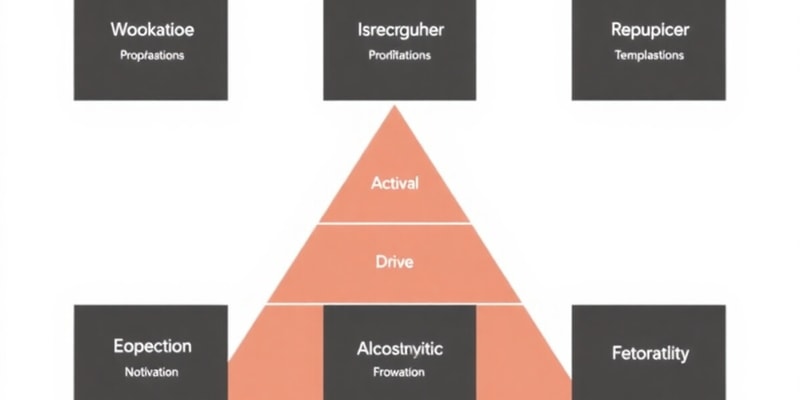Podcast
Questions and Answers
What determines the physiological responses in the body when experiencing hunger?
What determines the physiological responses in the body when experiencing hunger?
What is the primary concept of the Cannon-Bard Theory of emotion?
What is the primary concept of the Cannon-Bard Theory of emotion?
In Freud's psychoanalytic theory, which component is responsible for moral standards?
In Freud's psychoanalytic theory, which component is responsible for moral standards?
Which of the following best describes Maslow's highest level of need?
Which of the following best describes Maslow's highest level of need?
Signup and view all the answers
What is a common defense mechanism that involves attributing one's unacceptable thoughts or feelings onto someone else?
What is a common defense mechanism that involves attributing one's unacceptable thoughts or feelings onto someone else?
Signup and view all the answers
Which method is described as a technique to access the unconscious mind, according to Freud?
Which method is described as a technique to access the unconscious mind, according to Freud?
Signup and view all the answers
What characterizes the concept of introversion in personality?
What characterizes the concept of introversion in personality?
Signup and view all the answers
What is the focus of the Eysenck Personality Scale?
What is the focus of the Eysenck Personality Scale?
Signup and view all the answers
Study Notes
Motivation
- Motivation is the force that initiates, guides, and sustains goal-oriented behavior.
-
Drive-Reduction Theory
- Needs: Basic requirements for survival (e.g., food, water, shelter)
- Drives: Internal states of tension that arise from imbalances in our needs (e.g., hunger, thirst).
- Drive Reduction: The process of satisfying a drive by eliminating the tension.
- Homeostasis: The body´s natural tendency to maintain a balanced internal state.
- Incentives: External stimuli that motivate goal-directed behavior (e.g., rewards, money, praise).
-
Arousal Theory: Suggests that we are motivated to maintain an optimal level of arousal.
- Arousal: Level of alertness and activation.
-
Maslow's Hierarchy of Needs: A pyramid of needs where lower-level needs must be satisfied before higher-level needs become relevant.
- Basic (Lowest Level): Physiological needs (e.g., food, water, sleep).
- Highest Level: Self-actualization (fulfilling one's potential).
-
Physiological Effects of Hunger:
- Increased stomach contractions
- Decrease in blood sugar levels
- Release of hormones like ghrelin (hunger hormone)
- Activation of brain regions involved in food seeking.
- Ostracism: Being excluded or ignored by others, can lead to psychological distress and even physical pain.
- James-Lange Theory of Emotion: We experience physiological arousal first, followed by the emotional interpretation of the experience.
- Cannon-Bard Theory of Emotion: Physiological arousal and emotional experience occur simultaneously.
- Two-factor Theory of Emotion: Physiological arousal followed by cognitive appraisal (labeling the emotion) leads to the emotional experience.
- The Spillover Effect: Our emotional responses can be affected by the emotions of those around us.
- Facial Expressions of Emotions Around the World: There are some universally recognized facial expressions for basic emotions (e.g., happiness, sadness, anger), but cultural nuances can influence how these expressions are interpreted.
- The Facial Feedback Effect: The physical act of making a facial expression can trigger a corresponding emotion.
Pessimism
- Pessimism: A tendency to focus on negative aspects and expect negative outcomes.
- Personality: A person's unique and relatively stable pattern of thoughts, feelings, and behaviors.
- Freud's Unconscious Mind: A reservoir of thoughts, feelings, and memories below the level of conscious awareness.
- Accessing the Unconscious: The unconscious can be accessed through dreams, slips of the tongue, and free association.
- Dreams represent unconscious desires and conflicts.
- Free Association: A technique where a person relaxes and freely speaks about anything that comes to mind.
-
Freud's Psychoanalytic Theory:
- ID: The impulsive, primal part of the personality driven by pleasure.
- EGO: The mediator between the ID and Superego, strives for balance and reality.
- SUPEREGO: The internalized moral compass, represents societal rules and values.
-
Defense Mechanisms: Unconscious strategies that protect us from anxiety and stress.
- Projection: Attributing our own unacceptable thoughts or feelings to others.
- Displacement: Directing emotions towards a less threatening object or person.
- Rorschach Inkblots Test: Uses ambiguous images to reveal unconscious thoughts and feelings.
Personality
- Eysenck Personality Scale: Measures two primary dimensions: Introversion-Extroversion and Neuroticism-Stability.
- Introversion: A tendency to be reserved, solitary, and prefer quiet and intellectual pursuits.
- Extroversion: Characterized by outgoingness, sociability, and a desire for excitement and stimulation.
-
The Big Five Personality Traits (C.A.N.O.E.):
- Conscientiousness: Organized, responsible, and goal-oriented.
- Agreeableness: Cooperative, trusting, and empathetic.
- Neuroticism: Prone to negative emotions like anxiety and worry.
- Openness to Experience: Curious, imaginative, and open-minded.
- Extraversion: Energetic, assertive, and enthusiastic.
Stress
- Stress: A state of mental and physical strain caused by challenging situations.
- Stress Reaction: The body's physiological and psychological response to stress.
- Stress Appraisal: An individual's interpretation of a situation and its potential impact on their well-being.
-
Stress Management Techniques:
- Exercise (e.g., aerobic exercise).
- Relaxation techniques (e.g., meditation, deep breathing).
- Social support and relationships.
- Mindfulness practices.
- Time management skills.
- Benefits of Aerobic Exercise: Releases endorphins (natural mood boosters), reduces anxiety, and improves sleep quality.
- Optimism: A positive outlook on life, reduces the impact of stress by promoting resilience and coping mechanisms.
Studying That Suits You
Use AI to generate personalized quizzes and flashcards to suit your learning preferences.
Description
Explore the various theories of motivation including Drive-Reduction Theory, Arousal Theory, and Maslow's Hierarchy of Needs. This quiz will test your understanding of how internal drives and external incentives influence behavior. Challenge yourself to determine how these theories apply to real-life situations.



